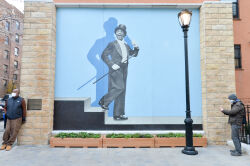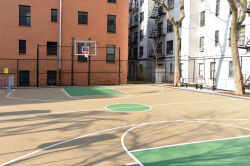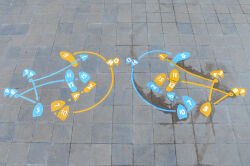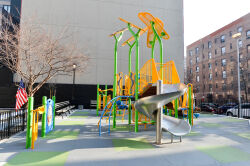Bill Bojangles Robinson Playground
Bill “Bojangles” Robinson Park
What was here before?
This was a vacant lot that was owned by John D. Rockefeller Jr. who was a financier, philanthropist, and son of Standard Oil co-founder, John D. Rockefeller.
How did this site become a playground?
In 1934, John D. Rockefeller, Jr., deeded the land to the City as a public park at the urging of Robinson who lived opposite this park at the Dunbar Apartments, home to many prominent African Americans, including W.E.B. DuBois and A. Phillip Randolph. It opened in November of that year. In 1992, an 18-foot high illusionistic mural depicting entertainer and philanthropist Bill “Bojangles” Robinson step-dancing was added. Based on a James J. Kriegsmann photograph and designed by Brandon Adams, the piece features a shadow cast by an actual period streetlamp of the type that existed in Harlem during Robinson’s heyday.
The playground was reconstructed in 2020 under NYC Parks’ Community Parks Initiative—a multi-faceted program to invest in under-resourced public parks and increase the accessibility and quality of parks throughout the five boroughs. It includes new playground equipment, the 1992 mural which was conserved, and pavers with dance steps as a nod to its namesake.
Who is this playground named for?
This site is named for Bill “Bojangles” Robinson (1878-1949). Born Luther Robinson in Richmond, Virginia, he and his siblings were raised by their grandmother, a former slave. Robinson left home at the age of eight for Washington, D.C., where he worked as a stable boy at the Benning Racetrack. Around this time, he assumed the name of his brother William and earned his nickname “Bojangles” after stealing a beaver cap from a hat maker named Boujasson.
Captivated by dance and the vaudeville tradition, Robinson soon was performing publicly and appeared in a successful 1892 run of Eddie Leonard’s minstrel show, The South before the War. He traveled the vaudeville circuit and became its first major African American star. His elaborate routines, including his unique “stair dance” made him a headline performer, and his extravagant habits helped create a larger-than-life persona.
Widespread publicity and his tap-dancing talents earned Robinson a starring part in the Broadway revue Blackbirds of 1928, and later roles in films beginning in the 1930s. Several films paired him with child-star Shirley Temple, and Stormy Weather (1943), his last of 14 motion pictures, co-starred singer Lena Horne. Robinson continued to perform in live theatrical productions, including The Hot Mikado at the New York World’s Fair of 1939-40 in Flushing Meadows Corona Park, Queens.
Amassing great wealth, Robinson gave away most of his earnings to charities and local organizations. Robinson’s commitment to the community earned him the honorary title Mayor of Harlem.
When Robinson passed away on November 25, 1949, his body lay in state at the 369th Regiment Armory on Fifth Avenue at 142nd Street in Harlem. Luminaries such as Jackie Robinson, Joe DiMaggio, Duke Ellington and Irving Berlin served as honorary pallbearers. Thousands of citizens witnessed the procession as Robinson’s motorcade to his final resting place in the actors’ section of Evergreen Cemetery in Brooklyn.
Check out your park's Vital Signs
Clean & Safe
Green & Resilient
Empowered & Engaged Users
Share your feedback or learn more about how this park is part of a
Vital Park System










